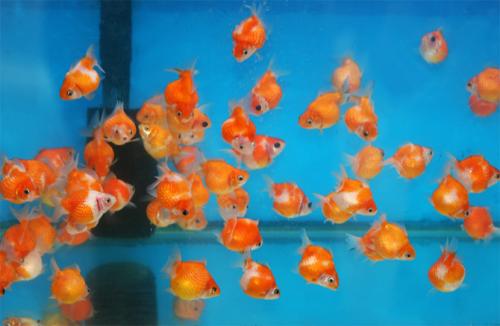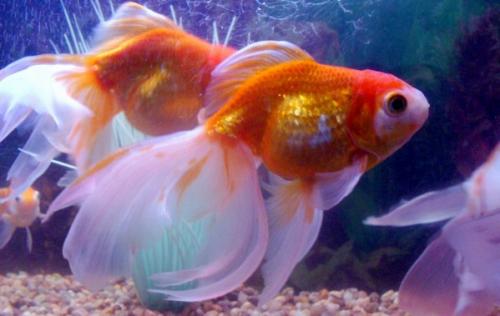How to take care of my goldfish
We all know what a gold fish look like but are we capabile of knowing what is this litel pet need?You might think that you do. Wait until you read this article and then answer that question.

Goldfish are hardy freshwater fish. While most people know about them, they do not necessarily know all about them. This article attempts to tell you a lot more. They originated from the Gibal Carp. Over the past 2000 years, beginning in China, Goldfish were the result of breeding and early genetic like experimentation. Unlike many other species, various genetic traits can be changed over 3-4 generations with Goldfish.
Wild "Goldfish" live in an environment of ponds, lakes, and other water holes and can be found in Moving and still water ranging from 50 to 90 degrees Fahrenheit / 10 to 32 degrees Celsius. The largest types of goldfish can grow to be upwards of 12 inches/ 30 cm and with weights around 5 ½ pounds / 2.5 Kg.
In the wild, their colors tend to be darker and paler which seems to be a direct result of the amount of light in their environment. Their colors actually include gold, bronze, and pink. They have a couple sub-hues of the sort too, metallic and calico.
It is time to shatter a myth, a dream about keeping goldfish. Those cute little bowls that are often sold containing goldfish are not the right environment for Goldfish. They need more room, as they can grow large and need high oxygen levels in the water. Something that is hard to maintain in a bowl. Small aquarium tanks are never wise for aquarists, as they can have more drastic (and fast) changes in the water quality. This means that the water very fast can turn toxic and kill your goldfish. You sometime hear people being proud that my new goldfish has lived for 3 or 6 month or something like that. A six month old goldfish is really nothing to be proud of as these fish can become 30 and even 40 years old with the proper care.
For a Goldfish aquarium tank, it is advisable to have a tank with a lot of surface area as that allows more water contact with the air which means more oxygen in the water. For every inch of Goldfish, you should have 30 square inches of surface area. Do not forget that they will grow, and some variety can become as large a foot / 30 cm.
Goldfish should be kept in freshwater and can in some areas be taken directly from the tap. Check with a local fish store to se if the water in your area is good enough to house fish in and use a good water preparation chemical. Make sure that new water that you add to the aquarium keeps the same temperature as the old water in the aquarium. You should always let your aquarium stand for about a week after first adding water to it before adding any fish. This process is called cycling and makes the water more suitable to support life.
Gravel on the bottom is wise, as it will help the Goldfish to feel more at home. About 1/8 inch is good. It is a good idea to avoid dyed gravel, as it might have contaminants that your Goldfish will not appreciate in terms of health.
Filtration are not, with good water changes, as necessary for Goldfish as they are with many other fish, though still a good idea and strongly recommended, as it will make your task a bit simpler and help you keep the water conditions good. The filtration will also start a current which increase the oxygen levels in the aquarium tank which is beneficial.
Oxygenating is a good thing as well. It will help release some harmful chemicals in the water, and helps oxygenate the water as well. A simple air stone, and pump for your Goldfish will help them live happier and healthier, and the cost are worth every penny of it.
Goldfish, like most other fish, do enjoy some environment to play in. Places to hide and find shade in. One other aspect, it is wise to have at least 2 goldfish, as they do like company. Loners in the fish world probably are not that much different from those in the human one. Do not leave your precious pet alone without someone to play with. Make sure all things in the tank are meant to be in a fish tank, and that they are clean, so they don't add harmful chemicals. Don't use any detergents to clean the fish tank and/or any part of decoration and equipment.
Lighting will help the fish to maintain the best color. Florescent Normal Output bulbs do well for Goldfish, although high output bulbs can make your goldfish colors look and be even brighter.
You should take care bringing the Goldfish home. Darkness, room temperature, and gentleness are a great idea, as they will help lessen the stress on the goldfish during the move. Another aspect is that it is wise to dim the lights before adding them to the tank to further reduce stress. Before releasing them into the tank you should let the bag float on top of the aquarium for a while. (At least 15 minutes) you should thereafter open the bag and but about a cup of water in it and than wait another 15 minutes. You should repeat this process 4 times before you release you fish in their new home. This will give the goldfish the possibility to slowly adept to the new water conditions.
Once things are up and running, you should change some of the water in the tank weekly. This helps remove stale water and clean out some debris. You should siphon about 15% of the water out and from the bottom at the gravel where the debris fall. Then replace the removed water with the fresh water, make sure that the new water has the same temperature as the water in the aquarium. If the water changes causes big changes in the water values it might stress the Goldfish.
Goldfish have special nutritional needs that are often available as "Goldfish Food." For example, Goldfish need more carbohydrates in their diet than many other fish species. It is wise to only add enough food for them to eat fully in 5 or 10 minutes. Any more will likely be waste resting at the bottom and worsen the water quality. It is better to feed them 2-3 times a day then it is once a day.

For the most pasionat of you i have other advices. If you are ever interested in breadin this littel creature just follew the steps:
Breeding goldfish can be a relaxing hobby but is not to be undertaken lightly as it will take time, money and patience. First off, you will need to invest in a large tank which will serve as the goldfish's home while you are breeding. Make sure you get good quality fixtures for the tank to keep your fish happy and healthy.
The most important task in breeding goldfish is choosing the variety of goldfish you want to breed. As a beginner, it is advisable to choose the small and easy to handle breeds of goldfish, the lionhead, red and white oranda and pearscale. After you have chosen the breed, select a male and female pair.
Be sure to choose a high quality goldfish for your breeding stock. Look at the body shape, color and size, and finnage to determine quality. An ideal male goldfish will show breeding tubercules on its pectoral fins and. While a female goldfish should be heavy but with a soft, slender body.
It's best to buy two male for one female fish. Try to get younger goldfish if you can as the younger fish produce more fertile eggs and in proper form, making them much better to breed than older ones.
When starting the breeding process, you first need to see to it that the fishes are ready to mate with each other. The first sign is when you see the male goldfish chasing the female around the tank. That is when the courtship will begin. You will also notice the colors of the fish change to a brighter color, this is in order to attract their mate.
Spawning of goldfish eggs usually start early in the morning or late at night. Then after an hour, the male will be able to spray its milts.
Do not change the water at this time, so that the female fish will be fertilized. After a few days, the male fish will become aggressive and will push the female fish around the tank this is when she will eject her eggs. The eggs will automatically stick on the plants of the tanks.
Watch the eggs carefully to look for growth and changes. Once you see that the eggs have already hatched, your work will begin. Remember that the parent goldfish eat their eggs so the need to be separated from the fry. Transfer one or the other to a new tank or container.
You must learn how to feed the fry (small baby goldfish). You need to use teeny particles of food like frozen shrimps, dried flakes, boiled egg yolks and even liquid foods. Make sure to give them food three times a day. Ensure that the food you have given is enough for the fry but not too much or you will effect the water quality in the tank.
If you give proper supplement for the baby fish, they will grow fast. As they grow, these fry must be transferred to a more comfortable tank.
Once they are large enough, transfer them to their new tank home and sit back and enjoy your new finned friends!

Thanks for reading this article. I'll come with more tips for all you animals lover out there.




